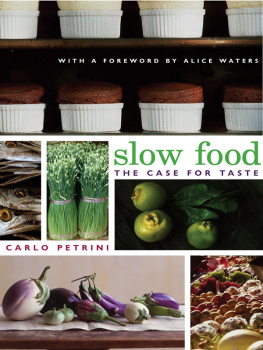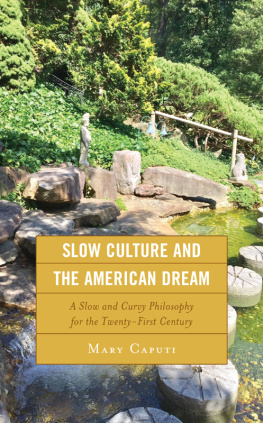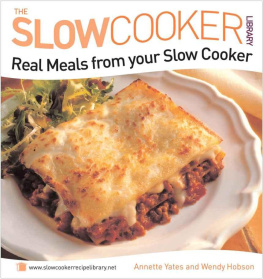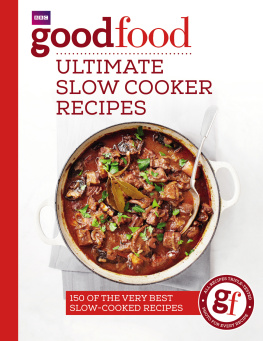Carlo Petrini
Translated by William McCuaig
slow food
T H E C A S E F O R T A S T E
 COLUMBIA UNIVERSITY PRESS NEW YORK
COLUMBIA UNIVERSITY PRESS NEW YORK
Columbia University Press
Publishers Since 1893
New York Chichester, West Sussex
cup.columbia.edu
Copyright 2001, Gius. Laterza & Figli Spa
This translation of Slow Food: Le ragioni del gusto is published by arrangement with Gius. Laterza & Figli Spa, Roma-Bari
All rights reserved
E-ISBN 978-0-231-50237-5
Library of Congress Cataloging-in-Publication Data
Petrini, Carlo.
Slow Food : the case for taste /Carlo Petrini translated by William McCuaig.
p. cm. (Arts and traditions of the table)
Includes bibliographical references and index.
ISBN 0231128444
1. Gastronomy. 2. Food habits. I. Title. II. Series.
TX631 .P474 2003
641.'01'3dc21
2002191189
A Columbia University Press E-book.
CUP would be pleased to hear about your reading experience with this e-book at .
Arts and Traditions of the Table
PERSPECTIVES ON CULINARY HISTORY
Albert Sonnenfeld, series editor
Salt: Grain of Life
Pierre Laszlo,
translated by Mary Beth Mader
The Culture of the Fork
Giovanni Rebora,
translated by Albert Sonnenfeld
French Gastronomy: The History and Geography of a Passion
Jean-Robert Pitte,
translated by Jody Gladding
Pasta: The Story of a Universal Food
Silvano Serventi and Franoise Sabban,
translated by Antony Shugar
I remember when in 1986 Carlo Petrini organized a protest against the building of a McDonalds at the Spanish Steps in Rome. The protesters, whom Carlo armed with bowls of penne, defiantly and deliciously stated their case against the global standardization of the worlds food. With this symbolic act, Carlo inspired a following and sparked the Slow Food movement. Three years later, delegates from fifteen countries came together in Paris to pledge to preserve the diversity of the worlds foods.
Since then, Slow Food has grown into a global organization that supports and celebrates food traditions in more than 40 countries worldwide. Slow Food has flourished in the United States as well. In the two years since a national office opened in New York, Slow Food convivia have sprouted in almost every state, and in this short time the U.S. membership has reached nearly 10,000.
Under Carlos remarkable leadership, Slow Food has become a standard bearer against the fast-food values that threaten to homogenize and industrialize our food heritage. Slow Food reminds us that our natural resources are limited, and that we must resist the ethic of disposability that is reflected everywhere in our culture. Slow Food reminds us that food is more than fuel to be consumed as quickly as possible and that, like anything worth doing, eating takes time. Slow Food reminds us of the importance of knowing where our food comes from. When we understand the connection between the food on our table and the fields where it grows, our everyday meals can anchor us to nature and the place where we live. And Slow Food reminds us that cooking a meal at home can feed our imaginations and educate our senses. For the ritual of cooking and eating together constitutes the basic element of family and community life. In short, Slow Food can teach us the things that really mattercompassion, beauty, community, and sensualityall the best that humans are capable of.
It gives me great pleasure to introduce this volume to American readers. A revolution in the way we eat is taking tangible form in this country. There are farmers markets in almost every city and the availability of organic food is expanding by leaps and bounds. In this book, Carlo Petrini eloquently articulates our mission, and I believe he will inspire more of us in this Delicious Revolution.
Alice Waters
The New York Times, in a recent editorial entitled Read This Slowly, asked its readers to consider the Slow Food Movement, which took hold in Italy in recent years and is spreading around the world at an impressive clip.
Carlo Petrini, founder of the movement, here offers to our readership a consideration of Slow Food, its origins, history, and principles. At a time when globalization is a subject not only for debate but also for angry demonstrations in the street, this book is an important addition to the Columbia Arts and Traditions of the Table series.
There were 130,000 attendees, 80 participating nations, and more than 2,000 accredited journalists at the 2000 Salone del Gusto (taste show) in Turin, Italy. For the 2002 Salone, suffice it to say that more than 100 American food and beverage taste workshops (stands), 11 seminars, two Taste America dinners, and American embassy sponsorship constituted eloquent proof that Slow Food is effectively casting off its original Italocentricity for the many Americans who (to quote the Times again) wish to wean themselves from the eat-and-run life.
The very name, Slow Food, originated in protest against the Golden Arches, that portal to the temple of fast food and to the caloric altar of its high priest, Ronald McDonald, who threatened to take over the plaza below the historic Spanish Steps in Rome in 1989.These birth pangs left the movement vulnerable to potential misunderstanding. Slow Food is not a gourmet food and wine society, though its meetings emphasize the rediscovery of the flavors and savors of regional cooking. The Slow Food Manifesto declares, A firm defense of quiet material pleasure is the only way to oppose the universal folly of the Fast Life. Nor is Slow Food any longer a gastronomic movement, per se; it offers an antidote to the insidious virus: Fast Life, which disrupts our habits, pervades the privacy of our homes and forces us to eat Fast Foods. In the name of productivity, Fast Life threatens to degrade the global environment and our local landscapes.
Here at the table lies the template for the preservation of human rights and the environment. TV chef Graham Kerr, formerly The Galloping Gourmet, now calls his program The Gathering Place. And Alice Waters has stated succinctly: Eating is something we all have in common. Its something we all have to do every day and its something we can all share.
Thus it was both predictable and normal that the manifestos proclamation of the defense of slow, long-lasting enjoyment begin at the table with Slow Food; just as the original table dhte of the movement (thanks to the Internet) was in the small Piedmontese market town of Bra (near the heart of the white truffle and Barolo district). Slow Food quickly evolved into a defense team for vegetable, animal, and cultural diversity, taking the stand for animal and human well-being in its periodical Slow, now published in Italian, English, French, German, and Spanish. Its public face has become that of a primarily educational organization, which realizes that food consumption cannot be divorced from issues of food production and distribution; its mission is defined as eco-gastronomic: for example, to convince the hygiene-obsessed EEC bureaucrats in Brussels, as well as the American public, that fresh produce is not dirty, though it comes without cellophane wrapping and looks unsymmetrical, and so unlike the waxen sterility of the processed and prepackaged products of the agribusiness industrial revolution.










 slow food
slow food
 COLUMBIA UNIVERSITY PRESS NEW YORK
COLUMBIA UNIVERSITY PRESS NEW YORK